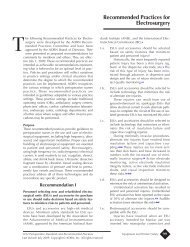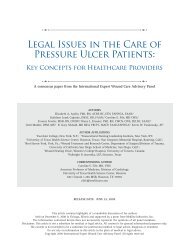2009 CAUTI guidelines - Centers for Disease Control and Prevention
2009 CAUTI guidelines - Centers for Disease Control and Prevention
2009 CAUTI guidelines - Centers for Disease Control and Prevention
You also want an ePaper? Increase the reach of your titles
YUMPU automatically turns print PDFs into web optimized ePapers that Google loves.
S. Further research is needed on the use of a portable ultrasound device to evaluate <strong>for</strong>obstruction in patients with indwelling catheters <strong>and</strong> low urine output. (Norecommendation/unresolved issue) (Key Question 2C)T. Further research is needed on the use of methenamine to prevent encrustation inpatients requiring chronic indwelling catheters who are at high risk <strong>for</strong> obstruction. (Norecommendation/unresolved issue) (Key Question 2C)Specimen CollectionU. Obtain urine samples aseptically. (Category IB)1. If a small volume of fresh urine is needed <strong>for</strong> examination (i.e., urinalysis orculture), aspirate the urine from the needleless sampling port with a sterilesyringe/cannula adapter after cleansing the port with a disinfectant. (CategoryIB)2. Obtain large volumes of urine <strong>for</strong> special analyses (not culture) aseptically fromthe drainage bag. (Category IB)Spatial Separation of Catheterized PatientsV. Further research is needed on the benefit of spatial separation of patients with urinarycatheters to prevent transmission of pathogens colonizing urinary drainage systems. (Norecommendation/unresolved issue) (Key Question 2D)IV. Quality Improvement ProgramsA. Implement quality improvement (QI) programs or strategies to enhance appropriate useof indwelling catheters <strong>and</strong> to reduce the risk of <strong>CAUTI</strong> based on a facility riskassessment. (Category IB) (Key Question 2D)The purposes of QI programs should be: 1) to assure appropriate utilization of catheters2) to identify <strong>and</strong> remove catheters that are no longer needed (e.g., daily review of theircontinued need) <strong>and</strong> 3) to ensure adherence to h<strong>and</strong> hygiene <strong>and</strong> proper care ofcatheters. Examples of programs that have been demonstrated to be effective include:1. A system of alerts or reminders to identify all patients with urinary catheters <strong>and</strong>assess the need <strong>for</strong> continued catheterization2. Guidelines <strong>and</strong> protocols <strong>for</strong> nurse-directed removal of unnecessary urinarycatheters3. Education <strong>and</strong> per<strong>for</strong>mance feedback regarding appropriate use, h<strong>and</strong> hygiene, <strong>and</strong>catheter care4. Guidelines <strong>and</strong> algorithms <strong>for</strong> appropriate peri-operative catheter management, suchas:15
















